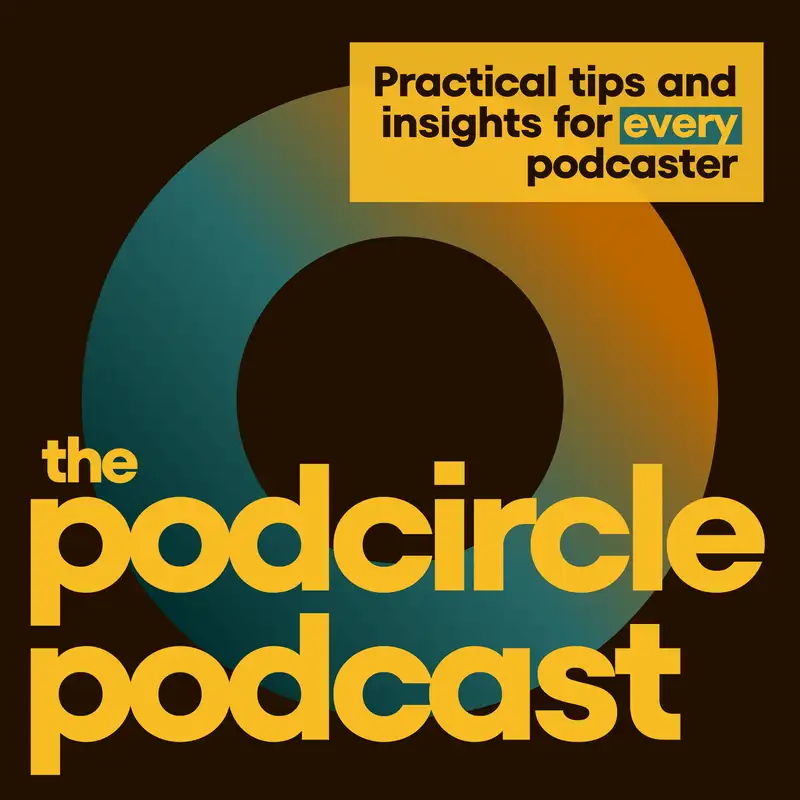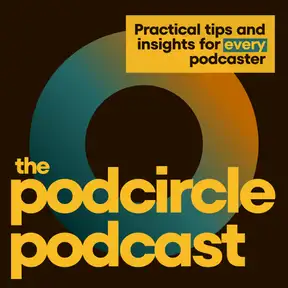29. Boost Podcast Engagement with These AI Tools
Most of the transcription services are really good until it comes to proper nouns, spellings of names, sometimes even places. You kinda always have to go back and check that stuff. Also, punctuation, I've I've noticed that the script adds so many commas, and I just don't like a lot of commas in my subtitles. So I'll go in and and remove almost all of them. And then a pro tip for you all regarding capitalization is I usually go all caps for my subtitles so then you don't have to decide what to capitalize versus what not to.
Kyle Cummings:That's just something that I do, a little tip that saves me a little bit of time. And then as we said several times in our last episode, this AI feature is great when coupled with a human to check and ensure accuracy. You know, I'm always going back through my subtitles, checking, make sure everything looks good and is translating well to the audience.
Mickenzie Vought:Welcome to the Podcircle podcast where we bring practical tips and insights for every podcaster.
Kyle Cummings:Whether you're just starting out or you're already a seasoned podcast pro, these conversations dive into all the topics that matter most to you. So welcome to part 2 of our series all about the rise of AI and how it's changing the podcast and the content game in general. So last week, we broke down 2 different products that are utilizing AI for recording and editing podcasts. And if you missed that episode, be sure to go back and listen. But today, we're gonna talk about AI features and assistance, specifically to help you up your video game and accessibility for your listeners.
Kyle Cummings:So as a reminder, we post all of our you our shows on YouTube. So you can head over to PodCircle's page there to subscribe and follow along with this episode and also catch up on some past episodes.
Mickenzie Vought:Also, if you're listening on Apple Podcast, we would really appreciate it if you would just take a few moments to leave us a 5 star rating and a quick review. You have no idea how much this helps us. Well, actually, if you're a podcaster, you do know how much this helps us. It's super simple. You can head to our main page and leave a review at the bottom.
Mickenzie Vought:Yeah.
Kyle Cummings:Totally. And if you're listening on Spotify, same thing. Just head to our main page. You can leave a rating right there at the top. Super easy. It helps us find more podcasters like you.
Mickenzie Vought:Alright. So let's get into it. If you've been listening to the Podcircle Podcast for very long, you already know our stance on video. Our motto is ABR, always be recording. We believe that recording video, even if you don't currently have a video podcast, is one of the best ways that you can up your podcast game and leverage your content to its greatest use.
Mickenzie Vought:So if you're not already recording, you're missing out. Start today. And especially if you're recording your interview remotely using a platform like our favorite Riverside or SquadCast, something like that will allow you to create social clips to YouTube clips and full video podcasts. There's just so much you can do with your video from your podcast. So video, as we continue to say is definitely the future of content, and certainly includes podcasts.
Mickenzie Vought:So for more on this topic, we really encourage you to check out episode 11, should I start a video podcast? So let's talk about AI and video.
Kyle Cummings:Yeah. Yeah. So AI is making great strides as you all probably already know to help content creators produce quality videos with simplicity and ease. And Mhmm. It's nice because you no longer have to be a videographer to have great video.
Kyle Cummings:There's so many great tools now. It's also just making strides and helping you better connect with your audience, through accessibility. So Mhmm. Here are 3 AI functions to consider utilizing. The first one is AI video captions.
Kyle Cummings:You guys have seen these captions are a huge deal. So subtitles on your video are no longer a quote unquote nice to have. They are now a necessity if you're putting out video for your consumers. A recent report from Verizon Media, they surveyed US consumers and found that 92% of people view videos with a sound off on their mobile devices.
Mickenzie Vought:Does that feel true for you, Kyle?
Kyle Cummings:Not for me. Okay. But I think and I wonder why that is. I could go you know? But I think if people are maybe scrolling at work, you gotta have sound off, but I work for myself.
Kyle Cummings:I'm around my my family all all day, and, you know, we can have sound on without there being any, you know, anyone noticing or whatever. But what do you think? What do you think that is?
Mickenzie Vought:Oh, I I definitely do it. I think I, like, just kind of mindlessly scrolling or even when I am, like, around my kids or whatever and they're doing something, I don't wanna, like, have added noise. I've got so much, stimulus coming at me anyway. So unless I really care about it, I don't turn the sound on.
Kyle Cummings:Oh, that's really interesting. That same report recommends that advertisers caption their advertisements because 80% of consumers are more likely to watch an entire video when captions are available. 37% of viewers watching captioned videos will turn the sound on because the captions spark their interest. That's interesting. There are several platforms on the market using AI to insert subtitles into your videos.
Kyle Cummings:The leader in the space is called Veed, v e e d. Mhmm. A few other fan favorites are captions, captions.ai. Mhmm. And the one that we use, is called Descript, which we talk a a fair amount about here recently in the podcast.
Kyle Cummings:So Veed boasts 98% accuracy in their subtitles and closed captioning, and they offer manual review and edit tools to ensure accuracy. Most of these platforms automate subtitles fairly quickly and then offer you the ability to review and edit and then customize the look of your subtitles by choosing a style, setting your font, adding animations, all that good stuff. Here's what I'm always tweaking when I'm in Descript. I'm always tweaking name spelling and capitalization.
Mickenzie Vought:Yep.
Kyle Cummings:So most of the transcription services are really good until it comes to the, you know, the proper nouns, spellings of names, sometimes even places. You know, if you mention a store or something, always you kinda always have to go back and check that stuff. Also, punctuation, I've I've noticed that the script adds so many commas, and I just don't like a lot of commas in my subtitles. So I'll go in and and remove almost all of them. And then a pro tip for you all regarding capitalization is I usually go all caps for my subtitles so then you don't have to decide what to capitalize versus what not to, all that good stuff.
Kyle Cummings:And, so that's that's just something that I do. You know? Yeah. The little tip that saves me a little bit of time. And then as we said several times in our last episode, this AI feature is great when coupled with a human to check and ensure accuracy.
Kyle Cummings:You know, I'm always going back through my subtitles, checking, make sure everything's looks good, and it's translating well to the audience. So I think it's a great starting point. It's a
Mickenzie Vought:great starting point. It's a great time saver being able to just, like, quickly go in and spot check it. I think that's great. Okay. So the second tool or function that you might wanna think about utilizing is AI video postproduction.
Mickenzie Vought:So we mentioned that with some of these AI tools available, you don't have to be a videographer to create quality video content. And many of the leaders in this space are offering remarkable and honestly kind of freaky AI features that help you post production. And some of these include video trimming, you know, AI, like, knowing that you started a video before you actually started your content and knowing where that ends. So that saves you some time. Eye contact correction, this is the weird
Kyle Cummings:thing. Wild.
Mickenzie Vought:Yeah. So sometimes when we're doing these podcasts, I'm looking in this left hand corner to read my notes. We could use AI and something like Veed. I think Veed captions and maybe even Descript all have it where they can
Kyle Cummings:get it. It as well. I haven't used it yet. I've seen it. I don't know if it's a beta feature, but it's a really new rollout. I'm curious to use it, just to try it out. I'm curious to see how
Mickenzie Vought:If it looks human or not. Yeah. Yeah. But that's an option. And then I think this is also interesting and I think would take some finessing, but they can also do lip dubbing if you go and rerecord something.
Mickenzie Vought:Let's say you messed up in the middle of it. You said the wrong name, but you had a really good take. Regardless, they can go in and insert that. And then through AI, we'll go in and correct the mouth movement, which is weird. And then removal of background noises or if you shot in a background that you don't actually want in your video, they can use AI to remove the entire background and color correction to make sure that videos match up and kind of match each other if you have 2 different angles.
Mickenzie Vought:So, again, there's a lot of really fun postproduction things that you can explore and try out and test, but our caveats are you get what you pay for. Occasionally, they might look a little wonky, and the more you add to it or the larger changes that you make, the less human it might feel. And, also, we said this in the last episode, these are consumer products. They're not professional products. So you're going to get a consumer AI in this season of where we're at, the people who are familiar with it are willing to lean in.
Mickenzie Vought:It's going to save you time, and you're going to be on the front of being able to interact with these tools. And I really think it's a great starting point, but we have to have a human to go back and check at this point. So my wrap up on this is that captions.aiandvideanddescript are the leading in this space on features, but several other platforms are really coming for their market share and trying to bring these AI, features as well.
Kyle Cummings:You know, we've talked a lot about Descript and Riverside. I think that people are looking for kind of an all in one recording, editing, postproduction solution. And the 2 that we see doing that really well are Riverside, especially on the recording side of things, and then Descript on the postproduction editing. And what we're currently using is Riverside to record our remote conversations and then dumping everything over into Descript. So, yeah, that's just what what's worked for us.
Kyle Cummings:And I think that, again, going to some of these, like, 3rd party sites like captions.ai. Although I think that their captions look awesome, and I know a lot of people that use it.
Mickenzie Vought:It's just another thing.
Kyle Cummings:Yeah. It's another thing. And so but if if it's it's really whatever works for you and works for the consumer.
Mickenzie Vought:The third feature I wanna talk about is transcriptions. So AI audio and video transcription has come leaps and bounds in recent years. We used to have to pay a dollar per minute for social video captions and transcriptions when I was a little baby social media marketer.
Kyle Cummings:Were you using rev.com?
Mickenzie Vought:Yes. We were. How do you know know?
Kyle Cummings:Oh, it's it was the only game in town for a long time.
Mickenzie Vought:For a long time. And it was kind of in the forefront of this when you actually needed captions. People weren't using captions from an accessibility standpoint or just from a user habit and the way people interacted with videos. We all watched them full fledged. They were shorter.
Mickenzie Vought:We didn't need captions. But now that we do and there's really moved that, you'll see a lot of different programs and companies have come into the space to simplify this. So now for one monthly fee, you can transcribe almost all the content you want. I've used a few different programs in the past, otter dot ai, most often, simply because it's the one that I started and I have, you know, a premium account on it. And I transcribe every single episode I do.
Mickenzie Vought:If you're looking to keep all your products under one service, the other options we've mentioned all have this capability as well-to-do pre and post video editing and transcriptions all in one as you were just saying. So a text transcription of your videos and podcasts are particularly helpful for SEO and accessibility to include a transcript in your show notes or to take that transcript and make it into a blog or use it for, you know, clipped up posts or LinkedIn or all the other things. So it's great to have that full transcription of your video podcast.
Kyle Cummings:You know what I just did yesterday? I went back and I'm going back through a lot of our episodes
Mickenzie Vought:Mhmm.
Kyle Cummings:And adding the transcriptions to, transistor, which hosts our podcast. That's kind of our our landing page for our, for our podcast. And I'm going in and adding transcriptions. Now they also, as you're about to get to here in a second Yeah. Transistor is about to roll out their own Mhmm.
Kyle Cummings:Transcription. So I'm I'm curious to see I'm gonna kinda a b test the 2 and see which one's more accurate. Because, again, when you get into name spellings, you know, even like the scripts, when we say, welcome to the Podcircle podcast, it, it turns Podcircle into 2 different Podcircle into 2 different words. And I you know, for SEO purposes, I want that to be right. So I'll I'll usually I'll go through and I'll do a word search within Descript and then do, like, a a find and replace type thing. So it all and even your name, Mickenzie.
Mickenzie Vought:I bet.
Kyle Cummings:So it's stuff like that. I'm curious to see how how Transistor does when they roll that out. But
Mickenzie Vought:Well, I'm curious to see when you go in and change it. Let's say, like, Mickenzie, for example. Yeah. I know that on Word, I can say, hey. This is always correct, so it doesn't try to correct it. I wonder if transistor or other platforms will start to learn the changes that you make on a consistent basis. Yeah.
Kyle Cummings:I don't know that I've seen anything to that end in the script. But one thing I do is add speaker labels. So each time one of us speaks, it says, you know, Kyle Cummings, and then I speak, and there's a time stamp. And having, I think, our names in there so often, just from an SEO standpoint is really valuable. And so I'm no expert in SEO.
Kyle Cummings:I don't I wouldn't pretend to be, but I I know that keywords are very important. Google is still a very, very powerful search engine.
Mickenzie Vought:Yes.
Kyle Cummings:Obviously, YouTube as well. So making sure that those transcriptions are available just adds more of those keywords to your site. Anyways, that kinda jumped in all over your point and got ahead of you a little bit. But
Mickenzie Vought:No. I love it. Well, what you were saying is podcast platforms are moving to include transcriptions right in your episode player. And so this spring, Apple is introducing transcripts on all Apple Podcasts, making it easier for anyone to access podcast and be able to read along while they're listening to it. So it's an accessibility play from Apple.
Mickenzie Vought:But according to Apple, with transcripts, your audience can read the full text of an episode, search the episode for specific words or phrases, and tap the text to play from that point in the episode. So I think it'll be great. And as the episode plays, each word's highlighted, making it easier to follow along. Transcripts are also easily accessible from the episode details page. So you can just touch and hold, and it'll reveal your transcript. But
Kyle Cummings:Yeah.
Mickenzie Vought:Here are the things that I think are the caveats in here. You cannot edit Apple's AI generated transcripts. So if you have things that you're consistently changing, you're going to want to use a third party to create your own transcription that you can go in and edit and then upload it. Apple is going to allow you to upload it through your hosting platform like Transistor. And then, like you mentioned, Transistor is adding a add on easy feature to do this right in when you upload.
Kyle Cummings:Yeah. Another AI feature.
Mickenzie Vought:Another AI feature they're using right in the platform that I think will be easier, and it's fairly affordable. So I think if you're not already using one of these other services and paying a fee for it, if you're using the free version or you just haven't tapped into some of these AI video features, it would be great to to rely on Transistor. I saw their pricing yesterday, and I was like, oh, that's actually not bad per episode.
Kyle Cummings:Yeah. Not at all. I was a little surprised that they that they put that feature behind a paywall. I'm not really aware of any other add on features that they have. But, hey, if it's if it's powerful and it's and it's good and the transcriptions are great, especially if you can go in and edit them to any degree, I wouldn't bat an eye at paying, you know, 5 or $10 a month by having that as an option.
Mickenzie Vought:Totally. And I think it'll be helpful for your consumers and how people as we're seeing how people are starting to consume media. They're reading it along with listening to it or they're
Kyle Cummings:just just noticing that yesterday when I was adding, because I was just copying and pasting the transcript over from Descript over into Transistor, and then I saw it. So on Transistor on our landing page, you can view the show notes or you can view the transcription. It's like there's like a 2 part to the page. Once I went over there, I found the time stamps, and I saw that they were clickable. I had no idea that that was that, I mean, it makes sense because you can do that in the show notes.
Kyle Cummings:Like, it makes the time stamps clickable, and you can skip around. But I noticed that the same thing was the case for transcriptions. Like, oh, that's really valuable. Because I think for a long time, podcasters have said, like, oh, yeah. You should add transcriptions and transcriptions.
Kyle Cummings:And I think a lot a lot of us have wondered, like, well well, why? Like, other than just, like, maybe an accessibility SEO thing, what what's the other use case that would validate needing to use transcriptions? And I think I found one yesterday. And Mhmm. Maybe you've known about this for a while, and other people have been using it that that way.
Kyle Cummings:But but I haven't. And and now I'm like, oh, that that might change the way that I interact with a podcast if I especially if I just find it online via Google search or, you know, some other way.
Mickenzie Vought:And you just wanna skip to a specific section. Yeah. Yeah. So I think those are really interesting tools for you to keep your eyes on and be conscious of for marketing and content purposes moving forward. AI is the future, but as we've been saying, it's not the end all be all for now.
Kyle Cummings:And we've just scratched the surface too. I mean, we Oh, yeah. Transparently, we cut we cut this episode down, and we cut some things out like AI avatars, AI voice clone. There's a lot going on, but we wanna keep it super simple and super practical just for the everyday podcaster and give you kind of the the stuff that's the most relevant to you. So all of that is stuff to keep your eye on, dig into it.
Kyle Cummings:Again, I use the script to edit this podcast and and make clips and things like that. It's something that I've been personally doing because I see the value in it, and I I think the script is becoming a really, really popular platform for, I would say, like, consumer slash prosumer podcast and even, like, postproduction agencies and stuff like ours. I wanna learn it really well. 1, because I would love to record some course content around it and teach other kinda do do it yourselfers how to use it. And, also, because I wanna be able to train our editors on how to use it for its benefit.
Kyle Cummings:Again, it's not a one size fits all package for us yet. I still use a couple of different programs to supplement Descript's deficiencies, like like Pro Tools. I still process my audio over there. I still think it's a really powerful platform, and I would love to train our other editors on how to use it when it's when it's a good fit for the client, if that makes sense.
Mickenzie Vought:Yeah. Totally.
Kyle Cummings:Well, that's it for this one. Thanks for tuning in on this episode. If you're looking to partner with an expert podcast team like Podcircle, help you produce a quality show, that's exactly what we do over here. So Podcircle creates premium podcasts for busy professionals. So if that's you, if that sounds like that's something up your alley, if you're whether you're a coach, author, speaker, entrepreneur, solopreneur, get in touch.
Kyle Cummings:You can schedule a call with me using the link in the show notes, or you can just simply drop me an email at kyle@podcircle dotcom. It's kyle@podcircle.com.
Mickenzie Vought:And if you're just getting started and want to launch your show with ease, you can get our complete podcast starter kit atpodcircle.com/start. And we wanna make sure that you are subscribed to the show where you listen. So whether that's Spotify, Apple, or if you're joining us on YouTube where we put full episodes in the video format, make sure you're subscribed so you never miss an episode. If you are watching on YouTube, how are you using AI for your podcast? What tools or features should we have talked about that we didn't?
Mickenzie Vought:So Yeah. We'll see you in the comments.
Creators and Guests




